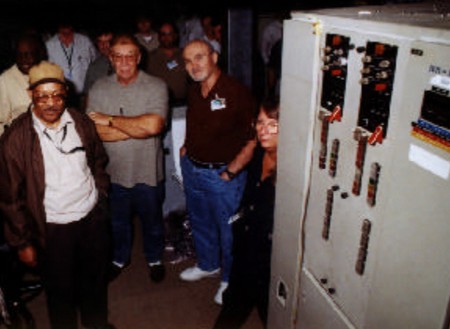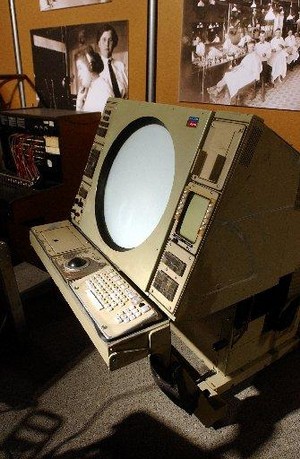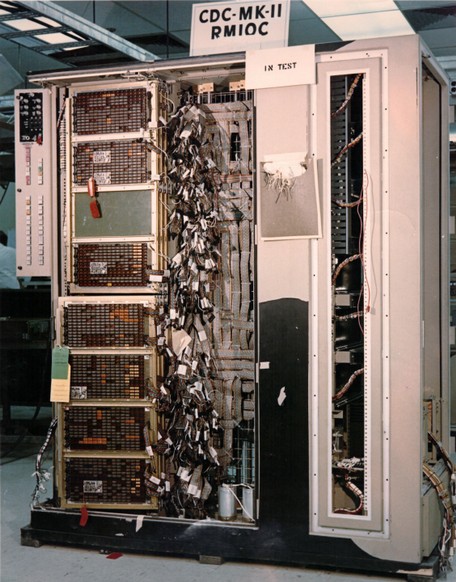Raytheon Computer Display Channnel (CDC) The birth of Radar Data Processing (RDP) | ||
Rick's Story With The Computer Display Channel As an Air Traffic Controller, did you ever wonder what black magic presented the data on that digital display. The CDC was located in the basement of the automation wing, a floor below the IBM 9020. The CDC acted as a peripheral device to the 9020 and was the system responsible for all the Buck Rogers Radar Data Processing technology. By the mid-1970s, the FAA had achieved an ATC system based on a marriage of radar and computer technology. Data appearing directly on the controllers’ scopes provided the identity, altitude, and groundspeed of aircraft carrying radar beacons. The elder controllers fought the change to RDP tooth and nail and swore the project was doomed to failure. Those that fought the system complained about being forced to act as computer operators, data input staff or just relegated to plain button pushers. After a few months, if we needed a PLANNED 4 hour shutdown for upgrades, those same individuals were the ones that screamed the loudest that they couldn't live without the system. The system consisted of about 30 tan colored boxes with pages of 4000 Series Integrated Circuits (IC). The chips were actually pluggable into sockets arranged like pages of a book. There were tens of thousands of these chips inserted into a wire wrap backplane. The system was designed in the early 1960s and contained redundant Raytheon 760 processors. I have a special attachment to this system and it's the primary reason that I retired as an Air Traffic Controller. I worked at five different ARTCCs as a Field Service Engineer for the Raytheon company. We were the follow up team after installation and responsible for the operation of the system and training of Airways Facilities (AF) for a six month period. After the field work, I was drafted (went kicking and screaming) to a tour at the Technical Center as a "Hardware Engineer." As a contractor, we were treated like second class citizens and our computer time was always an afterthought. We were forced to exclusive mid shifts for time on the system. I did not like my time there and couldn't wait to break out. I had to resign this position as a contractor TO the FAA in order to get hired BY the FAA as an Air Traffic Controller. A gentleman's agreement existed at the time that the FAA didn't hire contractor personnel and the contractors didn't hire FAA people. The ZLC CDC System had an operational life of 26 years, twice its design life. I almost felt like a part of this system, coming and going with its service dates. The functionality of the system was replaced by the Display System Replacement System in 1999 and the CDC was removed from the facility and scrapped (like me). See also: Welcome NOTE : We need pix of this system. If you have some, please send them for posting | Computer Display Channel Box  August 2000 AOS-300 recently gathered for a final farewell to some old friends, as the last of several Enroute Radar Display Systems were decommissioned at the Tech Center. The CDC system was operational for 30 years.  Another Computer Display Channel box  This digital Plan View Display (PVD) is a monochrome, 19 inch circular scope. It currently sits in a museum in Longmont, CO, home of the Denver ARTCC. This display could be used in a vertical (digital) or horizontal (analog - plastic shrimp boats) mode. | |
The box on the right is the Refresh Memory Input Output Control (RMIOC). It is the interface between the Data Processing Subsystem and the Refresh Subsystem. This photo was taken at the North Dighton, MA plant where the system was built and where we trained for our field assignments. The facility was housed in an old cotton plant and between 1901 and 1951 was one of the largest in the world. |  Photo courtesy of Mike Holmen | |
Comments
The past actually happened. It only becomes history when someone takes the time to write it down; preserving the legacy of Salt Lake Center for future generations. We want to ensure that stories, memories, and facility history are never lost or forgotten. The storytelling function was often the responsibility of older controllers as a way to make sure future generations learned about the history and heritage of our facility. A personal account of someone’s own experiences is much more effective than any text book. These stories need to be told.
From: Vincent Apicella
As I was in the process, along with 2300 other Chrysler Space Division engineers, of being laid off after we successfully launched Apollo 7, I was hired by Wayne Mumford and Tony Cerra from Ratheon Service Company to work with the Raytheon Sudbury CDC engineering design team (Ben Zupan, Roger Grenier, Bob Lockwood, Consultant Al Alvarez, and others, at Waltham Display Laboratory, where we made the first prototype " Raytheon 730 DPSS" portion of the CDC operational.
My job was to "shadow" Ben Zupan to understand his design functionality of the Input/output Controller (IOC) that connected the CCC IBM 9020's to Raytheon's 730 refresh subsystem for the PVDs. Other members of our RSC CDC team were: Bill Jones, Steve Olanof, Dennis Kendrick, Nelson DeGrandmaison, Gene Loftler, and others. Once the DPSS was operational, the Raytheon guys from Santa Ana brought the PVD refresh "back-end" to Waltham Labs to integrate it to the DPSS...then went to the converted old "Mt. Hope" mill building in Fall River, MA.
Now we took the whole 'thing' apart and moved it to the FAA NAFAC testing facility in Atlantic City. From AC to the FAA Academy in Oklahoma City to train FAA personnel... then to the FAA enroute equipment facility for LAX in Palmdale, CA. where we (all RSC personnel-no original Sudbury guys) successfully brought the first CDC "on-line"! From there on out, each of the original RSC team members were assigned a team field service engineers for 12 month contracts to follow-up the installation RSC fse on the six month contracts (Like you Rick). My next assignment was Weir Cook airport in Indianapolis with my team of eight fses...and so on, until the 22 airports had their CDC system operational.
From: Mike Holmen
Dennis, Nelson, Gary and I were hardware techs, we each had our own cabinet to work. There was also a set of EEs, one for each unit, however Nelson and I never saw our engineers as they spent most of their time upstairs at their desks.
I left Raytheon when congress was trying to figure out what to do about the CDC display, as it was having a hard time meeting specs. I went to commercial company, my first and last, and stayed there for about a year or two and then went back to Raytheon and was sent to the Albuquerque ARTCC to work on the Que system.
From there I was sent to the Miami ARTCC AND FROM THERE I WAS SENT TO THE Memphis ARTCC, but only was there for a week or so and got a offer to Raytheon SubSig. That was the last I had anything to do with the CDC project.
I herd from Dennis and Nelson a few years ago, Nelson is still in NJ no ides where Dennis is and the last I saw Gary he was going to school in FL as a gator.
